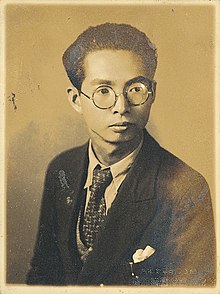|
The Torment of a Flower
 "The Torment of a Flower" (Chinese: 雨夜花; Pe̍h-ōe-jī: Ú-iā-hoe; lit. 'a flower at rainy night'), also known as "Rainy Night Flower", is a 1934 Taiwanese Hokkien song composed by Teng Yu-hsien and written by Chiu Thiam-ōng.[1][2][3] AboutTaiwanese writer Liau Han-sin (廖漢臣) wrote the lyrics of a children's song "Spring" (春天) and gave it to Teng Yu-hsien, asking him to compose for it. This was the earliest version of "The Torment of a Flower". Although Teng is a Hakka, he usually composed with Taiwanese Hokkien and not Hakka.[4] Some scholars have questioned this story about children's songs.[5][6] In 1934, while Chiu Thiam-ōng was working at record company Taiwan Columbia (古倫美亞唱片), he once went to a nightclub and heard a sad story about a girl who worked there.[7][8] Chiu was touched, and he decided to rewrite the lyrics of "Spring", wrote the story into Teng's music, that is "The Torment of a Flower".[9] It is the first collaborative work between Teng and Chiu. Especially, there was usually three part lyrics in Taiwanese Hokkien songs then, but there are four parts in "The Torment of a Flower".[10][11]
The first part of the lyrics means: "Blossom in a stormy night, pelted to the ground by the rain and wind. All by my lonesome, no one sees my constant grief for the blossom falling into the dirt that has no hope of revival." During the Second World War, the Japanese Imperial Warlord tampered with the lyrics of the song to declare that the Taiwanese under their rule love Japan. The Japanese version includes the line "How excited the honorable Japanese soldiers who wear red ribbons." (紅色彩帶,榮譽軍伕,多麼興奮,日本男兒。)[4] The song was played twice on a piano in the 2017 horror game Detention.[12] Notable performances
References
|
||||||||||||||||
Portal di Ensiklopedia Dunia